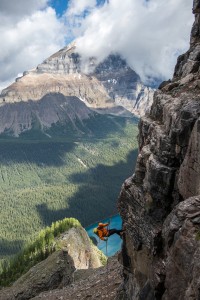Date: 26th June 2017
 Alpine climbing is awesome. Being up high, the sun rising, moving over vast amounts of terrain while feeling comfortable, deep experiences with friends, it’s just a great form of climbing. I’ve been alpine climbing for more than 30 years, and I learn something new every time I go out whether I’m guiding, filming or personal climbing. I can be a dense learner, but I think the complex and surprising nature of alpine climbing is what attracts me to it–just when I think I’ve got it figured out I’m wrong in a new way, and have to revise my model of how the alpine environment works. Here are a few “ideas” I find useful.
Alpine climbing is awesome. Being up high, the sun rising, moving over vast amounts of terrain while feeling comfortable, deep experiences with friends, it’s just a great form of climbing. I’ve been alpine climbing for more than 30 years, and I learn something new every time I go out whether I’m guiding, filming or personal climbing. I can be a dense learner, but I think the complex and surprising nature of alpine climbing is what attracts me to it–just when I think I’ve got it figured out I’m wrong in a new way, and have to revise my model of how the alpine environment works. Here are a few “ideas” I find useful.
1. Understand how the alpine environment changes dramatically every day. The mountains are sun dials, with predictable positive (cold hard snow in the morning for walking easily on) and negative (rockfall, avalanches) actions as the sun swings around the dial. Same with wind and snow. This knowledge is essential. It’s generally safe to be on still-frozen but southwest-facing snow, ice and rubble slope (or a slope threatened with the same) at 6:00 a.m. But put some sun on that slope and you’re in the rockfall mixer by 13:00. You have to understand how cold it was the night before to predict how frozen things are going to be, or not. Where the sun will be when, so you’re not exposed. In rock climbing it may get uncomfortably hot if you’re on a south-facing climb, but in alpine climbing there may be avalanches, rockfall, water, impossible wallowing where it was easy to walk earlier, etc. etc. You have to have a model of how the sun, weather, and mountains interact, and be in the right place at the right time to have good conditions. This is critical. Observe, ask questions, learn, learn, learn… Watch the mountains and see when snow slopes cut loose with the sun or wind. Refine your model endlessly.
2. Systems need to be appropriate. If you’re climbing difficult rock then it’s rock climbing, even if you’re over a glacier. Three-piece anchors, solid gear, etc. On the flip side, a t-slot (don’t know what that it is? Good time to learn…) may be all that’s needed to protect an awkward crevasse crossing with lots of snow to get the rope stuck in. Don’t use the rope unless it’s protecting you from something. So rope up on a glacier where the rope will help prevent a death crevasse fall, but don’t rope up marching up a steep snow slope unless you have gear in to stop a fall. Falling off roped together just kills more people, provides a false sense of security resulting in less solid movement, and the actual rope may hinder a self-arrest or proper step building. These are just examples I see in the mountains a lot–someone belaying a 5.9 crack off one cam with the comment of, “I’m alpine climbing bro.” Or three people tied to a rope at 15M intervals on hard 60 degree snow without gear. Don’t do that.
3. Solid feet are everything. It all comes down to solid feet. It takes a long time to learn how to really get solid feet in snow, bad rock, iced up rocks, thin ridges, etc. Moving fast and confidently is good, but only if you can really predict the next step and have competence in moving onto the next foot, over and over. I spend a lot of time coaching movement in the mountains; not falling off all begins with solid feet. A lot of alpine terrain involves soloing or runout where a fall would result in terrible injury. Your best gear is solid feet.
4. Know what you don’t know. It doesn’t matter if you can climb 5.12 and run six minute miles if you don’t know how to read a glacier to get to your climb. Get out lots so you know what you don’t know… Alpine climbing is often far more about all the “not climbing” parts than the climbing. Knowing how good you aren’t on a sketchy lead is often more important than knowing how good you are…
5. Leave early, fail early. It is way, way better to be back at the hut watching the lightning storm than it is to be on the summit experiencing that lightweight storm. Same with being caught out on a cold night, or in a snowstorm, or… Follow your time plan for the day, and if the plan is falling apart or the the day is changing go down. You can always go bouldering or something.
6.If any of your partners are prone to unplanned bivouacs or near-accidents or near-death experiences due to “unexpected” epics get a new partner. Seriously. People like this are wilful idiots, and will kill you both. Incompetency in the mountains is not a virtue, it’s lethal. Strive for competency, fun and success, not suffering. If you’re suffering or bleeding you’re doing it wrong.
7. Get the craft, find solid training, read. Know how to climb a rope to get out of a crevasse. Know what isothermal snow or a windslab is, and why that may be an issue. Learn, learn, learn… “Mentorship” in alpine climbing is often mis-used to mean some sort of bizarre near-death apprenticeship period. I don’t believe in alpine mentoring as it is commonly used, I believe in hard skills taught completely and well, preferably to industry and professional standards. Too many aspiring alpine climbers have shit alpine craft. I include myself in that category for much of my career.
8. Expand your mountain model continuously. I run a cross-sport “software model” for all my mountain sports. In paragliding my mental model identifies hazards, predicts thermal location based on the sun’s position and slope aspect, and keeps me clued in to the day’s evolving winds and weather. That model overlaps dramatically with alpine climbing, and vice versa. Every day you spend out in the mountains will teach you as much as you can learn if you listen, watch, feel, experience and make an effort to understand what is happening. This is the same as #1 really, just a more self-aware version of it.
9. Go until something stops you. I see too many people who are stopped by their imaginations before even leaving camp. If it’s an alpine climbing day get up and go until it doesn’t make sense to anymore. Even if you only get out of the car in the dark and listen to the mountains you’ll still learn something. At the bare minimum you’ll be better at getting up and leaving faster in the mountains, which is an easy way to get 30 minutes more sleep instead of futzing with your gear… Do the approach hike, and if you hear rock fall and it’s raining then go home, but at least you will have learned something. A lot of days are better than they seem, or worse, or just what they are. But you don’t know unless you go.
10. Fitness is number ten on this list, but most people would put it first. Fitness is good, but the above points are all way more important to competent alpine climbing. What’s more important than fitness is skill. Be a better climber. Build better belays faster. Kick your feet more effectively in soft snow. Plan better. Get out actually CLIMBING more and training in non-mountain environments less. The moderately fit but skilled alpine climber will succeed far, far more often than the hyper-fit climber with a lower skill level. Someone who knows how to feed their body well over a day will destroy the fittest person who doesn’t eat… Fitness good. Skills first.
11. Do a post-mortem on the day, week, year. What did you get right? Wrong? Adapt to successfully? Really screw up? Learn from all of this. Repeat consciously, with humility.
12. Get good partners who really like to climb. A surprising number of alpine climbers would rather talk about alpine climbing than do it. Avoid these people, they will suck your energy like vampires. No partner is perfect. Some are great once they get going but show up late, some show up on time and then try to kill you and them unless you manage that, it’s a relationship where the sum of the team is more important than the components. Some of my best partners have been lazy, old and prone to sleeping in like me, but we got up some good climbs because they liked to climb, and our risk tolerances fit together well. Thanks to my many partners for the days, and their knowledge is all over these ideas too.
13. Every day is a good day to come home. If you have that goal in your mind then good decisions tend to happen. But if you’re taking risks to get to the top, well… Over time life itself is lethal, but it’s always a good day to live.
14. Your ideas here. Because in the end it’s all your experience, ideas, and outcomes, not anyone else’s. That is alpine climbing–you write the exam and answers based on your experiences…
Posted in: Blog
Really good thoughts.
Know your self and your skills and do what u can do often and you will improve.
Keep it coming
15. Don’t switch off until you are back at the car. Assume that every decision you make while descending (from route-finding on rappel, to threading your belay device) is at least partially compromised by fatigue and/or dehydration. “Bounce test” your decisions with yourself and with your partner before you commit to them, just like you would your anchor.
they are all good, but #13!!!
Hi will
are there any books/reading material that you recommend for developing knowledge of the mountains/snow/weather/ glaciers? I see this as my biggest weakness within my alpine climbing.
Will, can you add some clarifying thoughts on #2, specifically the bit about bring ropes up without protection on steep snow?
I get where you’re coming from on that, but on the flip side lots of objectives will alternate between glacier travel, steep snow, and ice/rock that will need to be protected. Do you really recommend unroping for 500 ft of steep snow and then roping back up at the top for ice pitches, and then unroping again for more steep snow, and then roping back up again for some glacier crossing? Seems inefficient. In this context I am talking about terrain that the team would be very comfortable soloing, and simply keeping the rope on the for sake of efficiency.
Thank for sharing your knowledge and wisdom!
Hi Kyle, I do really recommend unroping for 500 feet of steep snow unless you have very good gear in between the climbers or pitch it out. If you go through back issues of Accidents in Mountaineering there are numerous examples of why climbing roped together on snow (or ice or rock) with a rope or without gear is a very bad idea (there are some exceptions for guiding, different beast, and even there the limit is often lower than we’d like to think). If you’ve just belayed some terrain and are entering 500 feet of steep snow with no gear the manage the transition by coiling the rope while bringing the second up for example. You’re going to have to stack the rope or manage it to start the technical climbing again anyhow, so it shouldn’t add much if any time to stow the rope and break it out again. It’s insidious how having a rope on effects behaviour–even though it’s worthless (and in fact more dangerous) people feel “safer,” and therefore don’t climb as though they are climbing with not only one life in their hands but the entire team’s… unless the rope is doing something useful get rid of it. I can’t think of many situations where staying tied together on steep terrain without good gear (even if it’s the snow or gendarmes on a lower-angle but very sharp ridge that are acting as the gear for example) is better than being unroped.
I like that.
Andrew, Check out Freedom of the hills. It is pretty much a textbook for alpine climbing and so full of information your head will explode. https://play.google.com/store/books/details?id=GwyXx4DzDjwC&source=productsearch&utm_source=HA_Desktop_US&utm_medium=SEM&utm_campaign=PLA&pcampaignid=MKTAD0930BO1&gclid=CLm0hs7z4NQCFUkefwodfl0F2w&gclsrc=ds&dclid=CMHvic7z4NQCFctmfgodbXUMug
#16 (a great #15 is in a comment above): Get after your objectives in order. Smart climbers do not start by climb Mt. Everest. Build your skills in a progressive. Fairly evaluate your long term objectives and make a plan to acquire the skills to achieve it safely. This requires patience, dedication, and planning but you will be better for it.
#17: Determine your turn around conditions before you arrive at the objective. Do you know that conditions are too much for your team if you start late, the wind is over 35 mph, or unexpected precipitation rolls in? Great. Decide that and review it with your team before you arrive at your objective. Insulate yourself from summit fever by making a plan *before* you set foot on the mountain. Remove the emotion from it.
And great article!
14. Look back at your route frequently as you go up. Get an idea of landmarks, the correct gully to descend, etc. Have a picture in your mind of the return route as you go up.
15. Manage party-induced rockfall hazard competently when climbing up or down unroped on loose terrain. Remember: the person in front going up or down manages the pace. That means the leader slows down if there’s more than 10′ of separation from his partner, to remove party-induced rockfall as a subjective hazard. My stomping grounds in the Cascades of Washington are notorious for bad rock, and we manage this constantly.
One of the best compilation of climbing-related thoughts and advice I’ve ever read — thanks! In an ideal world, these points would all be included in “common sense”, but unfortunately that is not the case.
One of the biggest killer in the mountains is the certanity that you are safe followed by the certainty that you aren’t safe but you’re prepared for the known unknowns, or prepared for the unknown unknowns. It’s Chutzpah to think that knowledge, skill, or experience will protect you from anything in the mountains. Some of the worst offenders are guides. Some of the worst mistakes aren’t due to the lack of expertise but laziness.
Lastly, be prepared to not come back. It’s the overlooked responsibility.
Great notes.
Hi Will!
I love reading your blog, very useful informations.
I am writing with a question to you: as to the usage (or not) of rope in summer alpine terrain (no snow)? When is it preferable to unrope, and when is it mandatory to use a rope? Let’s suppose it’s a party of two, both climbers, not a guided situation.
If exposure/risk of fall is high, it should be safer to be roped together, say, on an easier terrain, and placing some pro on the way? I feel like it brings it down to risk management. Is it OK to risk falling (steep but relatively easy terrain, hard to place pro, with great depth beneath), or preferable to be safer (by going slower and placing pro and being roped together and simul-climbing)?
When is it better to solo or simul-climb roped together? A recent accident I heard about brought these questions into my mind.
I’d love to read your thoughts on this.
Cheers!
Hi Peter, sorry for the delay! I think if the risk of a fall is high then pitch it out in some way. Maybe super short fast pitches in lower angled terrain, or longer pitches, but unless you are super confident no fall will occur then pitch it out generally. Any fall in a simul climbing situation is going to be very exciting and memorable. I very very rarely simulclimb, maybe a dozen times in the last 30 years honestly, and then I’m pretty careful about what tactics I use (Ti blocks, etc., it’s just sketchy). Often it is safer to solo in low angle terrain; the rope doesn’t knock rock off, you’re not rushing to keep up or ahead, etc. Snowy ridges are an exception, I often simul these with the theory one person will jump off the opposite side of the falling person. I’ve never done this, and am not excited about the idea, but it seems like it might work, or on that type of terrain the rope will get hung up on something.. Does that help?
I'm more than happy to hear your thoughts on what I've written. Please note that all comments will be moderated before publishing. Thank you for joining the conversation.



